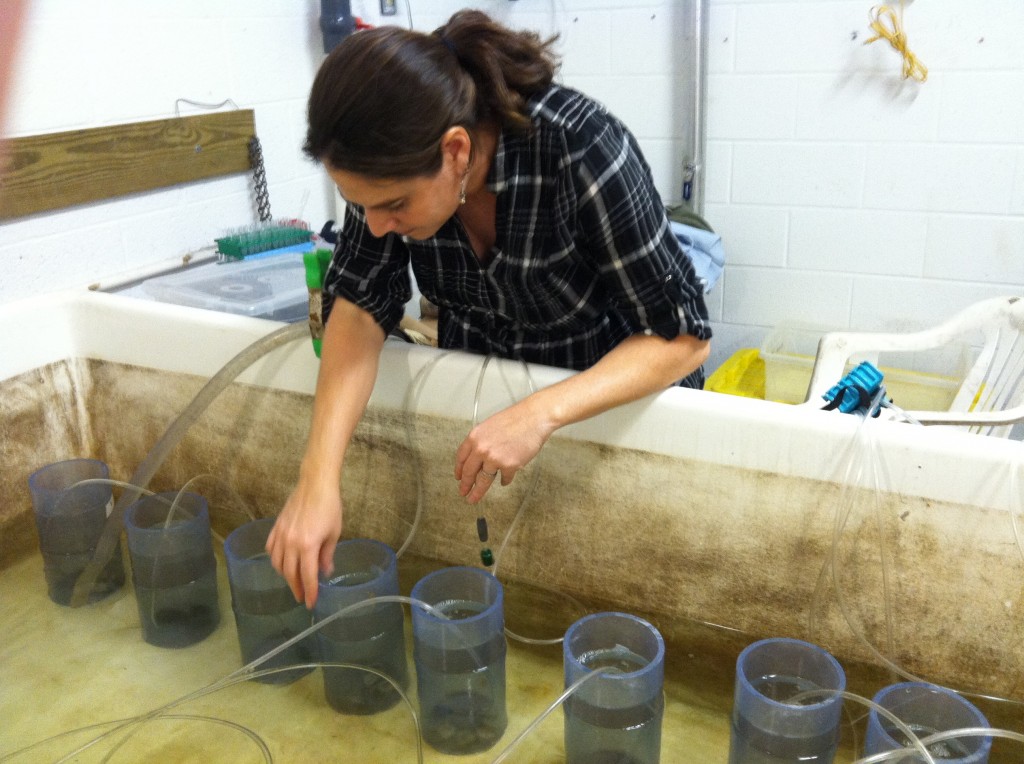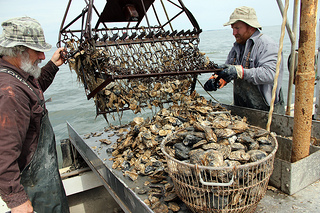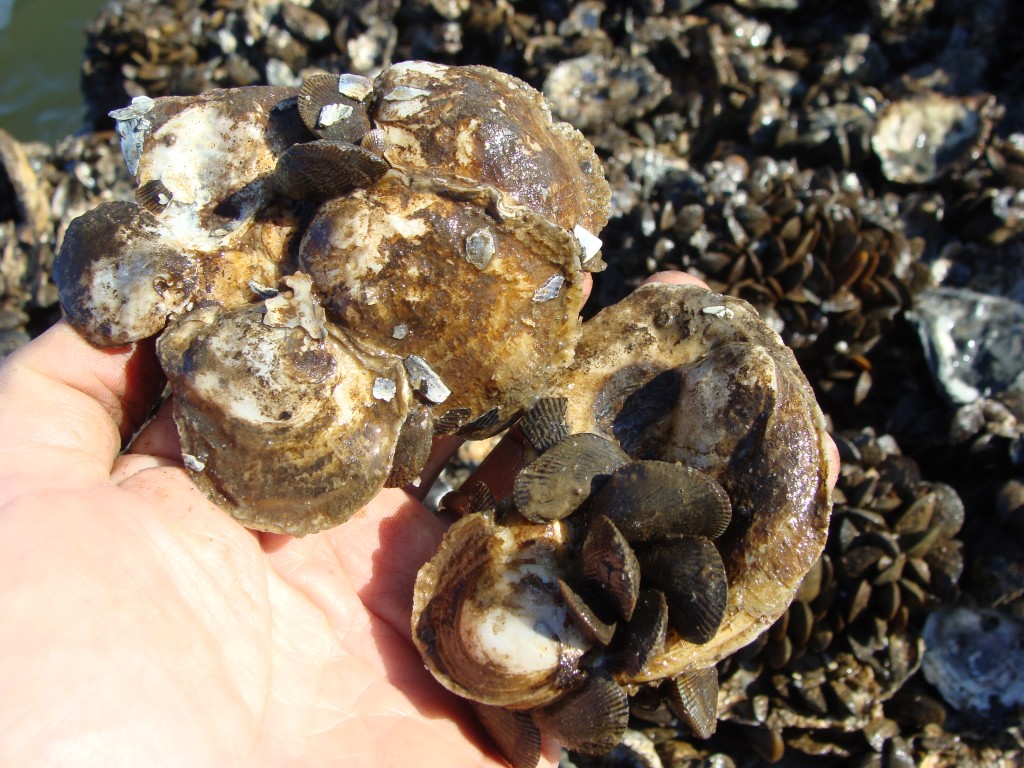By Sarah Hansen
Oyster restoration has long been championed as key to cleaning up Chesapeake Bay, because oysters’ filter-feeding lifestyle improves water quality by removing plankton. But oysters aren’t the only ones that can do the job. A new study reports that another bivalve, the hooked mussel, also removes its share of plankton from the clogged Bay.
When it comes to oyster reef restoration, “We’ll get more bang for our buck than we planned,” said Keryn Gedan, lecturer in the Biology Department at the University of Maryland-College Park, research associate at the Smithsonian Environmental Research Center (SERC), and first author on the new paper. As it turns out, hooked mussels not only have the power to improve water quality—they tend to settle in large numbers in oyster-rich habitats.
Oyster numbers in Chesapeake Bay are at less than one percent of historic levels, due primarily to overharvesting for human consumption. In response to the drastic decline, oyster reef restoration projects have sprung up throughout the region. The paper from Gedan and her colleagues, SERC senior scientist Denise Breitburg and Virginia Institute of Marine Science assistant research scientist Lisa Kellogg, provides evidence that restoration may be more effective than predicted.
Gedan measured the rates at which mussels and oysters removed plankton from tanks in the lab at ten different temperatures and with plankton in three different size classes. She also dredged at sites around the Bay to determine the oyster and mussel biomass at different locations. One of her co-authors, Lisa Kellog of the Virginia Institute of Marine Science, used a technique called patent tonging to accomplish the same task at other sites. Gedan referred to this technique as “rake and scoop.” Because it’s hard to see a reef’s inhabitants in the murky, turbid Bay water, she said, “The dredged samples are a good way to actually visualize the community.”

Gedan works in the lab to measure how quickly hooked mussels and oysters can remove plankton from the water. (Keryn Gedan)
After the field and lab work were done, Gedan used a mathematical model she adapted from previous work in Breitburg’s lab to calculate how much plankton the two species could remove at 17 sites in the Bay and its estuaries under four different restoration scenarios.
Gedan found that while oysters are still the filtering kings, because they are more efficient at removing larger plankton, hooked mussels are twice as efficient at removing tiny picoplankton. She and her colleagues estimate that a restored site with both mussels and oysters will remove more than twice as much plankton as a restored site without mussels. In fact, in a scenario with a 15-fold increase in oyster reef habitat, which represents restoration of Chesapeake Bay tributary Harris Creek, the model predicted that mussels and oysters together could remove more than 100 percent of the plankton in the summer. The same restoration without mussels would remove only half of that.
These are especially encouraging signs, because hooked mussels appear commonly on oyster reefs. Sometimes they’re even more plentiful than the oysters.
“They like to hide in the cracks and crevices of the oyster reef,” said Gedan. She saw three times as many mussels in oyster reefs with restoration activities. When snorkeling at a restoration site to collect mussel specimens, she “scooped them up by the handful.”

Watermen dredge for oysters, the same technique Gedan used to determine oyster and mussel biomass at her study sites. (Photo used under CC BY-NC 2.0 license)
At first glance, it seems like oysters and hooked mussels are happy roommates in the oyster reef. But their potentially complex relationship is poorly understood. “Oysters might shelter mussels from predation,” said Gedan, but they might also eat each other’s larvae. Another possibility is that chemicals released by one species attract the other to settle nearby. Gedan said that these seemingly contradictory interactions aren’t necessarily mutually exclusive and are worth investigating.
So what does all this mean for oyster reef restoration going forward? “We need to start thinking about how to facilitate the presence of other species on oyster reefs,” Gedan said. “At the very least, we need to start tracking different species.” Now that Gedan and her colleagues have shown how much other species can impact water quality, it will be important to make sure restored reefs are hospitable to those species, too.
Restoration is a promising prospect for increasing oyster abundance and improving water quality in the Bay, but there’s a long way to go. Gedan remembered gazing out at the catch from her dredge samples: “There were many more dead oysters on these reefs than live ones.” Even if it’s not looking good now, new approaches to restoration stimulated by Gedan and her colleagues may be the ticket to a healthier Bay.
The study was published in the July issue of Restoration Ecology. A full copy is available here.



Interesting story! In the northern parts of the Bay watershed, we also have dark false mussels on our oyster reefs and in hanging baskets of spat on shell at piers. These mussel-like clams also do a great job at filtering picoplankton. For a story on these mussels in the Magothy River, go to http://www.youtube.com/watch?v=-BHOtAd5KhU or go to youtube and search on dark false mussels. We would love to hear if other areas have these mussels at this time.
Its good that they are trying to restore the oyster population in Chesapeake Bay, but they are not factoring in the illegal fishing from
unlicensed fisherman which can hurt them a lot.They should think about that as well and think of some kind of way to protect the bay.
Like Richard said in hist post unlicensed fishing is a huge problem, but fishermen with licenses still do fish oysters like they fish dolphins in Bulgaria!